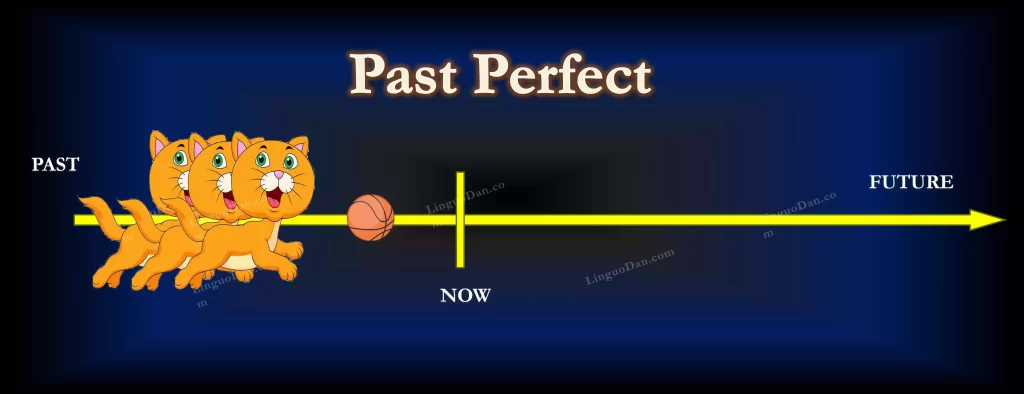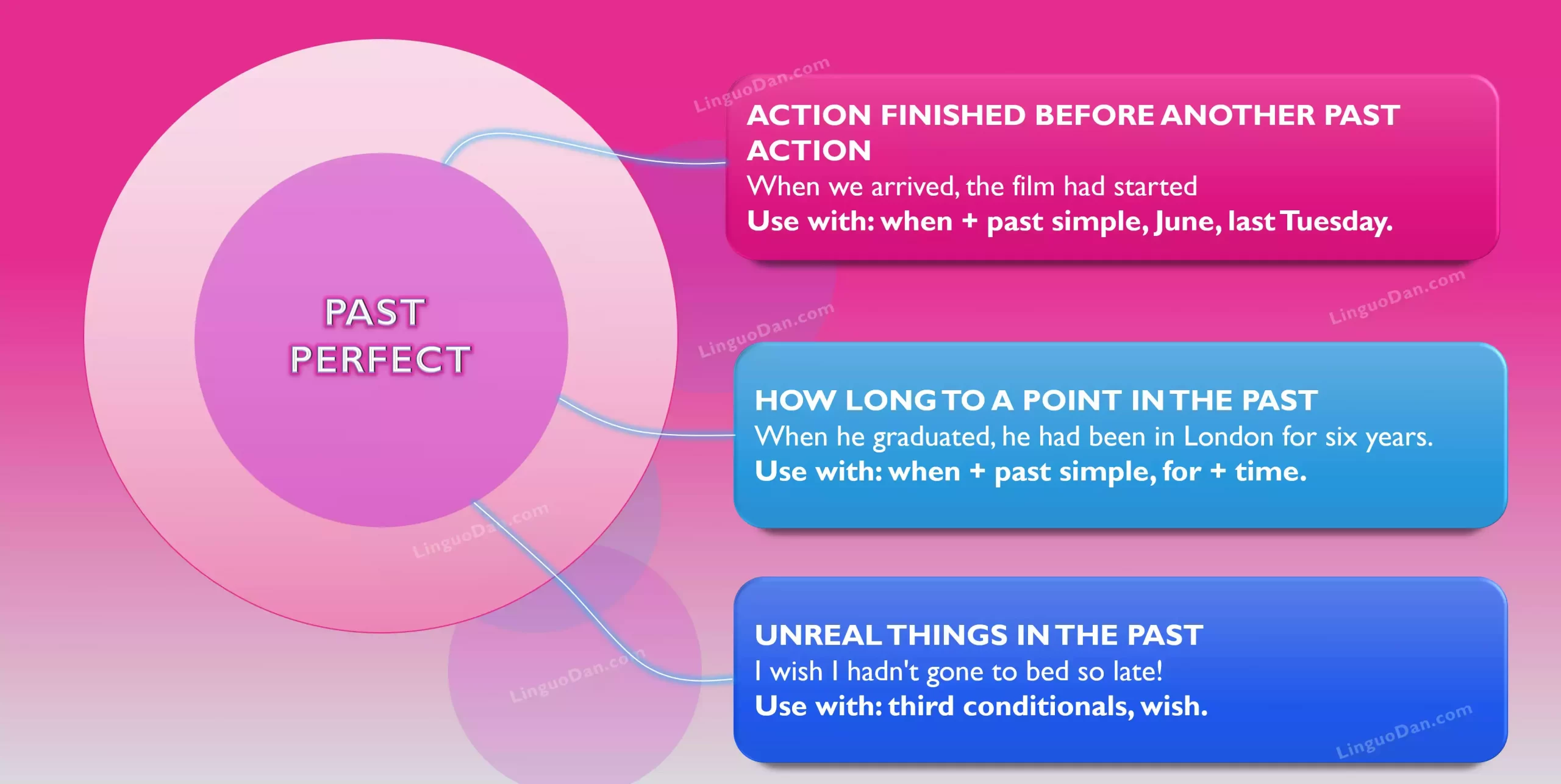Past Perfect Tense in English: Rules, Examples

Past Perfect Tense — Complete Grammar Guide
Past Perfect is used to show that one action happened before another action in the past.
- Formation: had + past participle (V3)
- Example: I had finished my work before she arrived.
Past Perfect is a verb tense in English used to describe actions that were completed before another action or moment in the past. It emphasizes that one action occurred earlier than another action in the past. Past Perfect is formed using the auxiliary verb “had” plus the past participle of the main verb: add -ed for regular verbs or use the third form from the irregular verb table.
📋 Quick Reference Guide – Past Perfect
✅ Affirmative: I had finished my work before she arrived.
❌ Negative: I hadn’t seen that movie before last night.
❓ Question: Had you ever visited Paris before 2024?
How is Past Perfect Formed?
| Sentence Type | Formula | Example |
|---|---|---|
| Affirmative 😊 | Subject + had + V3/Ved | She had studied English for 5 years |
| Negative 🙂 | Subject + had not + V3/Ved | He hadn’t finished his homework |
| Question 🤔 | Had + Subject + V3/Ved? | Had they arrived by 6 pm? |
📍 When Do We Use Past Perfect?
1. Sequence of Events in the Past
- Before: I had eaten dinner before the movie started.
- After: After she had called me, I went to the store.
- When: When I arrived, they had already left.
2. Cause and Effect in the Past
- He was tired because he had worked all night.
- She was happy because she had passed the exam.
- I couldn’t enter because I had forgotten my keys.
3. Experience Up to a Point in the Past
- By age 25, she had traveled to 15 countries.
- I had never seen snow before moving to Canada.
- They had lived in three different cities by 2020.
4. Unreal or Imaginary Situations in the Past
- I wish I had studied harder at university.
- If I had known about the meeting, I would have attended.
📅 Past Perfect Time Markers
| Marker | Meaning | Example |
|---|---|---|
| already | before expected time | I had already eaten |
| just | very recently | She had just arrived |
| never | at no time before | I had never seen |
| not yet | up to that time | hadn’t finished yet |
| once | one time | once he had understood |
| until that day | up to that point | until that day came |
| before | earlier than | before she left |
| by (time) | not later than | by 6 PM, by Monday |
| after | following | after he had gone |
| ever | at any time | had you ever been |
General Pattern with Regular Verb – to work
| Positive | Negative | Question |
| I/ He/She/It/ You/We/They had worked | I/ He/She/It/You/We/They
had not worked |
Had I/ He/She/It/You/We/They
worked? |
General Pattern with Irregular Verb – to go
Since this is an incorrect verb, turning to the table we get:
| INFINITIVE | PAST SIMPLE | PAST PARTICIPLE |
| to go | went | gone |
Then, according to the scheme, we will get:
| Positive | Negative | Question |
| I/ He/She/It/ You/We/They had gone | I/ He/She/It/You/We/They
had not gone |
Had I/ He/She/It/You/We/They
gone? |
Past Perfect is also called The past of the past or double past. This is because this tense indicates that something happened earlier than the Past Simple.

💼 Detailed Examples with Explanations
- “She had finished her work before she went home.” 👆 Sequence: 1) finished work → 2) went home
- “The train had left by the time we got to the station.” 👆 Sequence: 1) train departed → 2) we arrived at station
- “He had already eaten when I arrived.” 👆 Sequence: 1) he ate → 2) I arrived
- “I couldn’t find my keys because I had left them at the office.” 👆 Cause-Effect: 1) left keys → 2) couldn’t find them
Real-Life Examples
Work and Education:
“I couldn’t find my keys because I had left them at the office.” I couldn’t find my keys because I had left them at the office (first left them, then looked for them)
Travel:
“She had visited Tokyo twice before she moved there permanently.” She had visited Tokyo twice before she moved there permanently
Daily Life:
“When I got home, my family had already eaten dinner.” When I got home, my family had already eaten dinner (first they ate, then I came home)
🔄 Past Perfect vs Past Simple
| Past Simple | Past Perfect |
|---|---|
| When: Completed action in the past | When: Action before another past action |
| Example: I ate dinner at 7 PM | Example: I had eaten dinner before she came |
| Focus: The fact of the action | Focus: Sequence of actions |
| Usage: Single action | Usage: Two related actions |
💡 Remember: Past Perfect = “what happened BEFORE something”, Past Simple = “what simply happened”
Comparison Examples:
- Past Simple: I watched a movie yesterday. (Simple fact)
- Past Perfect: I had watched the movie before she arrived. (Shows sequence)
🔗 Past Perfect + Other Tenses
Past Perfect + Past Simple (most common combination):
- I had studied English for 3 years before I moved to London.
- After they had finished dinner, they went for a walk.
Past Perfect + Past Continuous:
- She had been working there when the accident happened.
- I had been waiting for an hour when the bus finally arrived.
⚠️ Common Mistakes and Tips
❌ Mistake: I had went to the store. ✅ Correct: I had gone to the store.
❌ Mistake: Had you went there before? ✅ Correct: Had you gone there before?
❌ Mistake: I have studied before I came here. (wrong tense) ✅ Correct: I had studied before I came here.
💡 Useful Tips:
- Past Perfect is often used together with Past Simple to show sequence of events
- Use Past Perfect only when it’s important to show that one action was earlier than another
- With irregular verbs, always check the third form in the irregular verb table
- Don’t overuse Past Perfect – use it only when sequence matters
🎯 Quick Knowledge Test – Past Perfect
1. When I arrived, the meeting _____ already _____. a) had started b) has started c) was starting
✅ Correct Answer: a) had started Explanation: The meeting started before I arrived
2. She was upset because she _____ her phone. a) had lost b) has lost c) lost
✅ Correct Answer: a) had lost Explanation: First she lost her phone, then she was upset
3. _____ you ever _____ sushi before yesterday? a) Have… eaten b) Had… eaten c) Did… eat
✅ Correct Answer: b) Had… eaten Explanation: Experience up to a point in the past
4. I couldn’t drive because I _____ my license at home. a) had forgotten b) have forgotten c) forgot
✅ Correct Answer: a) had forgotten Explanation: First forgot the license, then couldn’t drive
5. By the time we arrived, the concert _____. a) had started b) has started c) started
✅ Correct Answer: a) had started Explanation: Concert started before our arrival
🔗 Want More Practice?
Take the complete Past Perfect test with 40 questions